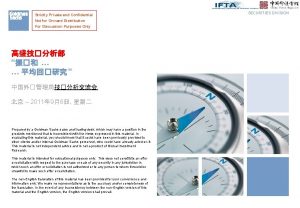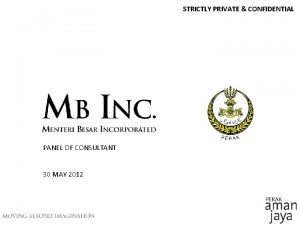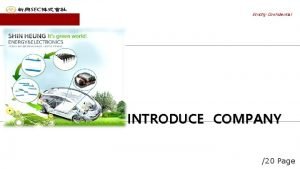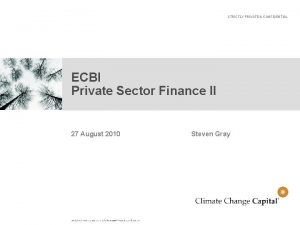STRICTLY PRIVATE CONFIDENTIAL Financing Energy Efficiency in the





- Slides: 5

STRICTLY PRIVATE & CONFIDENTIAL Financing Energy Efficiency in the iron, steel and cement sectors 18 May, 2009 F: Financing EE in China. ppt

Financing in the Iron, Steel and Cement Sector n The four most important financing sources for firms in China are: (domestic) bank loans, firms’ self-fundraising, the state budget, and foreign direct investment (FDI). } Self-fundraising includes proceeds from capital raised from local governments (beyond the state budget), equity and bond issuance and other investors, internal financing channels such as retained earnings, and all other funds raised domestically by the firm. n Iron and Steel sector §China’s iron and steel sector, accounts for about 15% of national energy use Iron and steel producers are substantially owned and controlled by the Chinese government and/or are subject to substantial government intervention. From 2000 to 2005 China’s state-owned banks, provided a direct subsidy to some companies. } Loans were based on political directives from the central or provincial governments, rather than creditworthiness or other market-based factors. §Restructured Chinese state banks that have already offered these companies much debt financing in the past years, are more careful and reluctant to provide further credit. n Cement Sector §China's cement production and consumption has been number one in the world since 1985. §The cement industry in China is a very fragmented sector comprised of a large number of small companies and outdated production capacity. Chinese government has a policy of encouraging an increased concentration and consolidation in the cement sector. §Restricted by access to capital, medium and small enterprises are finding it difficult to expand, providing the opportunity for large enterprises to merge and acquire them. Large companies get preferential treatment in terms of project approvals, land use permits and bank loans. F: Financing EE in China. ppt 2

Financing Energy Efficiency in China Financing options for energy efficiency in Chinese industry n China has gradually eliminated public funds earmarked for industrial energy efficiency project financing. The expectation is that Chinese enterprises would invest their own resources and banks to build energy conservation lending business lines, given the economic and financial attractiveness of such projects. However, this has not happened. n Three key barriers that have impeded the development of the lending market (debt financing) for medium and large-sized industrial energy efficiency investments: 1. Highly technical and unfamiliarity with this type of investment 2. Chinese banks perceive lending to industrial energy projects as highly risky. Lack of capacity to understand assess the positive cash flow contribution from energy efficiency investments. 3. Insufficient institutional capacity, especially at the national level, to address the pressing needs of scaling up energy efficiency investments. n Possible response to this lack of financing } (ESCO) financing. - ESCOs cooperate with technical institutes, technology experts and financiers with implementation/execution capacity to form a special purpose entity focused on energy savings. Energy Saving Companies n Key Barriers for ESCOs in China 1. Access to Capital. - Local commercial banks do not understand the ESCO business model and are not prepared to lend against future cash flows, preferring asset based collateralisation. 2. Policy Barriers. - There are still policies to be finalised and set in place to support ESCO businesses (e. g. unresolved tax issues with service fee arrangements). 3. Contract enforceability. - enforceability of the service agreements and the reliability of counterparties. A culture of renegotiation raises serious risks for ESCO companies. 4. Standards for the industry have not been established by related authorities. F: Financing EE in China. ppt 3

Recommendations n Uptake of efficiency measures depends on energy cost, capex requirements, market outlook and policy. n Dedicated programmes are essential to support entities and attract financial intermediaries that will be able to channel finance and bring the technical expertise needed. } The creation of special purpose vehicles, following and Energy Servicing Company model can help bring together the technical expertise and channel the required finance } Cumbersome joint venture procedures do not encourage their formation; hence a regulatory framework that promotes this type of ventures is needed. } Support is also needed from local institutions to facilitate enforceability of the service agreements. n Credit lines and loans from International Financial Institutions (IFIs) to kick-start new business areas in banks (energy conservation lending) and integrate the new line of business into their regular operations. n Local commercial banks find it difficult to provide loan finance to companies that do not have collateral against which to secure loans. Governments do not need to act as capital providers for projects to happen, but rather can share the risk through financial products such as risk mitigation instruments } Credit and loan guarantees and insurance products to cover debt services defaults will help improve the credit rating of entities or projects, improving access to capital n Where the risk is mainly associated with technology, risk instruments can also be used to support other financial products. Guarantees can also cover technology risk. F: Financing EE in China. ppt 4

Contact Climate Change Capital CCC Head Office Climate Change Capital 3 More London Riverside London SE 1 2 AQ United Kingdom Tel: +44 (0)20 7939 5000 Fax: +44 (0)20 7939 5030 www. climatechangecapital. com F: Financing EE in China. ppt 5








